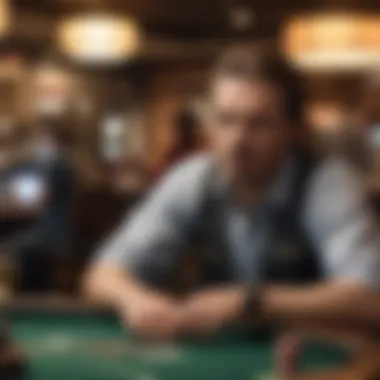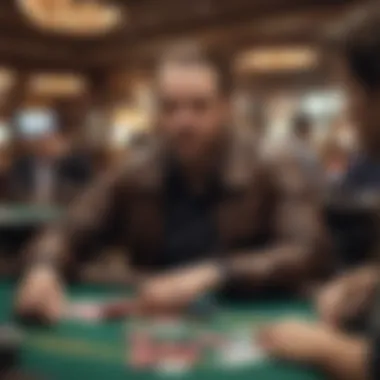Understanding 1000 to 1 Odds Payout in Betting


Intro
In the vast arena of betting, the odds are what make the game more than just a simple guess. They serve as a key indicator of the potential return on a wager. When we talk about 1000 to 1 odds, it might conjure images of long shots and hope. But delving beyond this initial impression reveals a complex landscape where skill, strategy, and a touch of luck converge. Understanding these odds is not merely about numbers; it’s about one’s approach to risk, intuition, and methodical planning.
This article aims to shed light on the intricacies involved in navigating the world of 1000 to 1 odds, from deciphering what those odds signify in practical terms to employing effective betting strategies. Bettors and gaming aficionados need to grasp the balance between risk and reward. Whether you are a seasoned player or someone pondering their first bet, the insights provided here can arm you with the knowledge needed to make informed decisions.
With a focus on strategic approaches and nuanced implications, we’re about to kick off our exploration into the enigmatic realm of betting. Knowing the ‘why’ behind the odds can often be just as crucial as the final payout itself.
Prelude to Odds in Betting
In the world of betting, understanding odds is crucial. It’s not just numbers on a screen; they shape how bettors engage with various types of bets. By grasping the fundamentals of odds, players can make informed decisions about where to place their money. This section will establish a foundation for comprehending the broader topics to come, especially the significance of those rare, yet tantalizing, 1000 to 1 odds.
Defining Betting Odds
Betting odds signify the probability of a particular outcome happening, as perceived by the bookmakers. Simply put, odds tell you how much you stand to win relative to your stake. They’re often displayed in varying formats, each serving its purpose but ultimately pointing to the same idea: calculating potential returns based on a stake.
For instance, if you wager $10 on a horse race with 1000 to 1 odds and it wins, your payout would be an eye-opening $10,000. Knowing how odds translate into potential winnings is essential for any bettor looking to navigate risky waters.
Types of Odds
Diving deeper into the realm of betting odds, it’s essential to recognize that they come in three primary forms. Each type has its merits and nuances, making some preferred over others depending on individual preferences.
Decimal Odds
Decimal odds present a straightforward number that indicates the total payout rather than just the profit. For example, if a player sees odds of 10.00, it means for every $1 wagered, they would receive $10 if successful.
The primary benefit of decimal odds is their simplicity. They are prevalent in Europe and Canada, offering an easily digestible format for calculating potential returns. Yet, some critics may argue they lack the nuanced appreciation of risk compared to other formats. The unique characteristic of decimal odds makes them a solid choice for bettors who prefer clarity over complication.
Fractional Odds
Fractional odds are mainly used in the UK and depict the profit relative to the stake. If you come across odds of 1000/1, it means that for every $1 bet, a successful wager returns $1000 in profit plus your original stake back.
One key characteristic of fractional odds is their historical context, rooted deeply in horse racing. This format can often feel more natural for traditional bettors. However, newcomers may find them somewhat complex, as they require a bit of mental gymnastics to decipher the payout.
American Odds
American odds can be a bit of a puzzle at first. Displayed as either a positive or negative number, they indicate how much a wager will pay on a $100 bet, or how much one needs to wager to win $100. For instance:
- A +1000 means a profit of $1000 on a $100 bet.
- A -1000 indicates that a bettor needs to place $1000 to win $100.
These odds are often used in the United States and have become very popular due to their potential to showcase significant payouts, especially in scenarios like football or basketball. However, their format can be unintuitive for newcomers navigating the betting scene. The unique contrast between positive and negative odds helps to highlight the level of risk involved in different bets.
Historical Context of Betting Odds
To fully appreciate betting odds today, it’s interesting to glance back at their evolution. Over centuries, odds have transformed, influenced by societal changes and betting culture. Originally rooted in informal agreements between betters, they have since taken on mathematical precision thanks to the establishment of professional bookmakers.
Notably, the historical aspect sheds light on how bettors perceive risk and reward in today's landscape. As decades rolled on, the shifts in public sentiment towards gambling—combined with advancements in technology—redefined the odds-making process and broadened the accessibility of betting to the masses. While some might say history is just old news, understanding this context is paramount for bettors seeking not just profit but insight in their wagering habits.
Exploring the Concept of to Odds


In the realm of betting, the odds you encounter can shape your strategy and outcomes significantly. Among various odds, 1000 to 1 stands out as a peculiar figure that evokes both intrigue and skepticism. Understanding these odds is essential for anyone looking to dive deep into betting, especially if you're considering high stakes where the reward could be monumental.
This segment dissects the notion of 1000 to 1 odds, shedding light on various elements surrounding them and the advantages they might present. Recognizing the contexts in which these odds emerge not only equips you with the knowledge to consider their potential but also arms you against the pitfalls of misunderstanding high odds betting.
Understanding Probability and Payouts
When you see 1000 to 1 odds, it initially appears intimidating, unless you break it down into manageable pieces. Effectively, these odds imply that for every 1,000 instances of an event, only one of them might occur. A deeper dive into probability gives you a clearer view. Payouts associated with these odds often turn large sums into winners of extraordinary proportions.
The calculation of potential returns from such bets can be elucidated simply: if you wager $1, a successful bet pays out $1,000 plus your original stake. The thrill lies not only in the immense return but also in the gamble that such an occurrence is rare. This complexity offers an intriguing mix of risk and reward which further draws bettors into its allure.
When Do to Odds Arise?
In the unpredictable world of betting, understanding when to find 1000 to 1 odds is integral. These periods often emerge in specific scenarios:
Rare Events in Sports
Have you ever watched a game where a huge upset was afoot, and the odds reflected just how unlikely it was? This is where 1000 to 1 odds can really shine. Rare occurrences, such as a bottom-tier team defeating a top-tier opponent, frequently attract such long odds. What makes these situations special is their unpredictability; they are often few and far between. The benefit to the bettor, however, is the potential for a massive pay-off if they can spot that diamond in the rough.
Long-Shot Bets in Horse Racing
Horse racing is notorious for giving rise to tantalizing long-shot bets. Certain horses with long odds might be viewed with skepticism but can occasionally springboard into surprising victories. The nature of races can yield unexpected outcomes, creating an environment ripe for 1000 to 1 odds. This unpredictable aspect itself makes it a thrilling choice for bettors who thrive on excitement. However, like any long bet, there’s a heightened level of risk attached—an essential consideration for any potential bettor.
Novelty Bets and Promotions
Novelty bets offer a whimsical side to betting that can also lead to long odds. These can include betting on the outcomes of unusual scenarios, such as who will win a reality show or what color a car will be at a certain event. Often, promotions by betting agencies can stretch odds as high as 1000 to 1 in an effort to engage bettors. While they’re entertaining, one should carefully examine the factors at play, as these bets often come with their own sets of risks and limitations that might not apply to standard wagers.
Case Studies of Successful to Bets
Examining how bettors have successfully navigated 1000 to 1 odds could provide valuable insights. Real-life examples demonstrate how those with a keen eye on probability and these long-shot occurrences can reap significant rewards. These inspiring cases often highlight the fusion of research, intuition, and sometimes sheer luck that culminates in remarkable wins. Observing these moments can offer inspiration as well as a more profound understanding of how to approach similar bets wisely.
By delving into the intricacies of 1000 to 1 odds, we forge a path not only towards the lucrative but also towards a deeper understanding of the betting landscape. It serves as a reminder that while the allure of high returns is tempting, knowledge and strategy wield a significant influence over success.
Calculating Potential Returns
Calculating potential returns is a cornerstone of effective betting, particularly when engaging with long odds like 1000 to 1. Understanding how returns materialize from wagers can illuminate the relationship between risk and reward. It's not merely about knowing what your bet could yield, but understanding the intricacies that influence those figures.
For bettors, calculating potential returns creates clarity. It enables participants to make informed choices, minimizing the likelihood of unpleasant surprises post-bet. As with every gamble, there's no sure thing, yet knowledge contributes to a bettor's overall strategy. In this segment, we will parse the calculations and elements that can sway payouts in your favor, ensuring you hold the upper hand in your betting endeavors.
Basic Calculation of Winnings
To calculate your winnings, especially with odds as steep as 1000 to 1, the formula is straightforward:
[ \textWinnings = \textStake \times \textOdds ]
So if a punter places a $1 bet at 1000 to 1 odds:
[ \textWinnings = 1 \times 1000 = 1000 ]
However, remember that these calculations only provide a glimpse of the potential outcome. Real relevance lies in understanding all influencing factors.
Factors Influencing Payout Amounts


Diving deeper, payouts don’t exist in a vacuum. Several elements play a crucial role in shaping how much one ultimately walks away with.
Stake Size
The size of your stake undeniably plays a significant role in determining potential returns. Typically, the larger your stake, the higher your potential payout. This makes it a common choice for seasoned bettors who are willing to risk more to gain more. However, it’s essential to keep in mind that larger stakes also carry a higher risk.
- Key characteristic: A larger stake amplifies both risks and rewards, making it a tool that can lead to significant gains or devastating losses depending on one’s betting acumen.
- Its appeal often lies in the potential for high returns, especially in scenarios involving extraordinary odds like 1000 to 1.
In a practical sense, the unique feature of stake size is its direct correlation to winnings; however, this also introduces the prospect of heavy loss. Betting large just because the odds are attractive might not always be the most prudent decision.
House Edge
The house edge is another vital factor influencing payouts. This represents the bookmaker's built-in profit margin, which varies by game and bet type. Understanding the house edge is essential because it directly affects your overall return on investment.
- Key characteristic: The house edge can subtly diminish your actual returns, reducing the expected value of your potential wins.
- Recognizing this element helps bettors evaluate whether a bet is worth the risk—especially under long odds.
The unique aspect of house edge becomes evident in the long-term outcome of betting strategies. If you only consider the odds without factoring in the house edge, you might be setting yourself up for disappointment in the long run.
Taxes and Fees
When contemplating potential winnings, it’s easy to overlook the implications of taxes and fees. Many states impose taxes on gambling winnings, while some betting platforms charge service fees that chip away at your profits.
- Key characteristic: Understanding the tax obligations and fees associated with betting ensures bettors have realistic expectations of their take-home amounts.
- The unique feature here is that while you might cash in big, the actual money received could be less than anticipated due to these deductions.
It’s not just about winning big, but acknowledging that taxes and fees can shape how much of that win remains in your wallet.
Understanding True Value of High Odds
Having delved into the nuts and bolts of how to calculate potential returns and the factors that influence them, it’s crucial to grasp what the true value of high odds is. Betting at 1000 to 1 odds can seem alluring, yet price does not equate to worth. Understanding the undercurrents of each bet is paramount. Balancing between the thrilling allure of high-risk wagers and the reality of odds and math can steer a punter toward more informed decisions.
Risk Analysis of Long Odds
The realm of betting is a high-stakes game, and navigating it requires a careful examination of risk versus reward, particularly when it comes to betting on long odds like 1000 to 1. This section delves into the essential aspects of assessing risk within the context of such long odds. By understanding the subtleties involved in betting at these margins, enthusiasts can better inform their decisions, ultimately enhancing their overall betting experience.
Evaluating Risk vs. Reward
When considering a bet with 1000 to 1 odds, the alluring promise of a giant payout can blind betters to the inherent risks. It's crucial to gauge not just the potential monetary gain but also the likelihood of actually hitting that bet. Weighing these elements involves a few steps:
- Identify Market Conditions: Look into the factors affecting the event you're betting on. Seasonal changes, player conditions, and external circumstances can affect the odds considerably.
- Consider Are the Odds Justified?: Often, odds reflect an event's improbability. A deep dive into recent performances, historical data, and any relevant metrics can reveal whether those odds hold water.
- Be Prepared for Loss: Long odds imply that winning is an exception rather than a rule. Thus, entering these bets with a sound strategy in mind, while possessing the mental fortitude to accept losses, is essential.
To put these elements into perspective, it helps to remember that betting is not solely about winning; the thrill and passion often come from engaging with the process. Betting on long odds means playing a game within a game.
Psychological Aspects of Betting on Long Shots
Betting on long odds can engage more than just your analytical side. The psychological journey involved is complex. Considerations include:
- Hope and Disappointment: A 1000 to 1 bet certainly amps up the hope. Yet that hope also comes with a bitter aftertaste when the outcome isn't favorable. Understanding this scope of emotional investment is key.
- Chased Losses: It's common for bettors, overwhelmed by the grandeur of potential payouts, to stake more in an effort to recoup losses. Such behavior inevitably clouds judgment and leads to deeper, more impulsive betting decisions.
- Superstition and Bias: Engaging in long-shot bets often leads to personal biases or superstitions that tempt bettors to follow their gut rather than data. Recognizing these tendencies is crucial for maintaining a logical betting mentality.
By acknowledging these psychological factors, bettors can better prepare themselves for the emotional swings that accompany high-risk bets.
Common Mistakes in Long Odds Betting


Even seasoned bettors can find themselves tripped up by similar pitfalls recurrently. Here are some common missteps to avoid when placing long odds bets:
- Neglecting Comprehensive Research: Simply going by "gut feelings" rather than solid metrics often leads to misguided bets. Spending time understanding team dynamics, statistics, and situational factors can greatly enhance decision-making.
- Ignoring Betting Limits: Many bettors fail to set strict limits for their betting activity, often leading to overspending without realizing it. Implementing a defined budget can serve as a guardrail against reckless wagering.
- Falling for the Hype: Market volatilities can cause fluctuations in odds, swaying betters to leap on a bandwagon. Stay grounded and avoid betting based solely on consensus opinions.
- Underestimating the House Edge: Every betting platform has a house edge, which can significantly eat into payouts, especially on longer odds. Betters need to be aware of this reality and factor it into their calculations.
"A wise bettor is acutely aware of their limitations and surroundings; they know that long odds can reap enormous benefits but often may not deliver the outcome expected."
By avoiding these common traps, bettors can maintain a disciplined approach and make better decisions—essential in enhancing their journey in betting, particularly when dealing with 1000 to 1 odds.
Strategies for Betting on to Odds
Betting on odds as high as 1000 to 1 can be a rollercoaster of emotions and excitement. However, diving in without a plan can lead to a big headache. Here, we talk about how to navigate this tricky terrain, shedding light on strategies that can make the journey smoother. The right strategies can transform a daunting gamble into a calculated move toward potential reward.
Research and Knowledge Acquisition
When throwing your money into a bet with 1000 to 1 odds, it’s crucial to do your homework. Knowledge is your best friend. This isn't about having a hunch; it’s about gathering concrete info that can guide your decisions. For instance, knowing a team’s history or a horse’s performance on a specific day can provide insight into those long odds.
Before placing your bet, consider these tips:
- Studying Trends: Look at the performance of participants in similar contexts. This could include their past statistics or even their behavior in critical matches.
- Understanding the Market: Keep an eye on how the betting odds shift. This often reflects what others think about the possible outcomes.
- Utilizing Reliable Resources: Don’t rely solely on gut feeling; use data from reputable sources like Britannica or Wikipedia.
Bankroll Management Techniques
Managing your bankroll is like balancing your checkbook. It’s important not to go overboard when the stakes are sky high. Divide your fund in a way that allows you to stay in the game longer, even if things go south.
Some essential pointers include:
- Setting Limits: Decide beforehand how much you’re willing to lose. It’s easy to get swept away in the excitement of high odds.
- Progressive Betting: Consider using a system where you only increase your stakes after a win. This way, you minimize losses.
- Consistent Review: Check your bankroll often to understand how your strategies are working or if adjustments are needed.
Diversification of Bets
Don’t put all your eggs in one basket. While a single bet at 1000 to 1 can be enticing, diversifying your bets can help cushion the fall if things don’t pan out as expected. Think of it as spreading your wings: it broadens your options while reducing risk.
Here’s how to diversify effectively:
- Multiple Long Shots: Instead of one massive bet, consider placing smaller bets on several long-shot opportunities. This not only spreads out your risk but can also keep the action going.
- Mixing Bet Types: Combine long shots with more likely outcomes. This mixture can balance out your potential overall returns.
- Temporal Diversification: Don't place all your bets at once; space them out. This gives you time to evaluate results and make informed bets as new information becomes available.
Remember, the key to successful betting on high odds is a blend of research, smart money management, and strategic diversification. Buckle up, make informed decisions, and who knows? You could end up on the winning side.
Culmination: Betting with Insight and Prudence
As we delve into the world of betting, particularly in regard to hefty odds like 1000 to 1, it’s essential to know what we’re getting into. This article reassessed chances and payouts, shedding light on the allure and pitfalls tied to exceptional odds. When considering bets of this magnitude, a measure of caution coupled with strategic insight is non-negotiable.
Summarizing Key Takeaways
Reflecting on all that we’ve explored, several crucial points emerge in regard to 1000 to 1 odds:
- Understanding the Odds: Grasping what 1000 to 1 odds truly represent—essentially, an extremely low probability event occurring—gives a bettor insight into just how rare these chances are.
- Calculating Returns and Risks: Remember, calculating potential payouts is just as vital as knowing the odds. A simple calculation can determine whether the pursuit of a bet is worth the stake.
- Long Odds Require Strategy: Engaging with long odds demands more than just luck. Employing strategies such as proper research and understanding the sport or event significantly increases the bettor's chances for success.
- Importance of Knowledge: Being informed about the nuances surrounding betting odds can make a substantial difference in decisions, helping to shift the odds slightly in your favor.
In short, as enticing as a 1000 to 1 payout may sound, it’s imperative that one approaches such betting opportunities with a sound strategy and an understanding of the inherent risks involved.
Encouraging Responsible Betting Practices
Betting, while thrilling, has its fair share of responsibility. Venturing into high-odds scenarios without a plan is akin to sailing a ship without a map. Here are a few best practices:
- Set Limits: Establishing clear limits on how much one is willing to bet helps in maintaining discipline and avoiding potential financial pitfalls.
- Educate Yourself: Continued education about betting odds, probabilities, and strategies can empower bettors, equipping them to make informed decisions.
- Avoid Chasing Losses: It can be tempting to double down after losses, thinking the next bet could be the big winner. This often leads to further losses. Staying measured in betting practices is crucial.
- Seek Support: Engaging in discussions on platforms like Reddit can foster a community where advice can be shared and experiences discussed, guiding responsible betting.
In summary, purchasing a ticket to the game of odds is possible, but it comes with the necessity of thoughtful preparation and caution. Betting at odds like 1000 to 1 might promise grand returns, but only a prudent, informed approach will ensure a rewarding experience.















